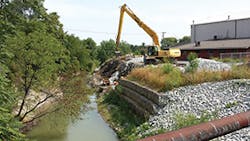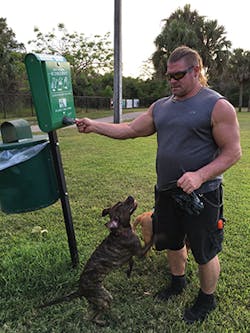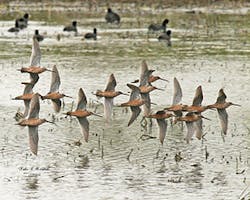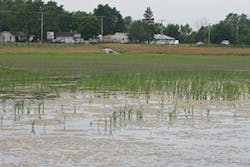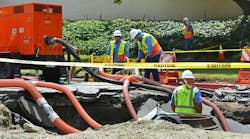The images in the news are telling: flooded streets after a weather event speak of backed-up stormwater infrastructure.
As EPA point out, improper maintenance of stormwater green and gray infrastructure inhibits the ability of stormwater to filter into aquifers or flow into streams and rivers. Built-out areas with impervious surfaces can result in stormwater runoff rushing into storm drains, ditches, and sewer systems, causing downstream flooding, streambank erosion, increased turbidity, habitat destruction, combined sewer overflows, infrastructure damage, and contaminated streams, rivers, and coastal waters.
Maintaining stormwater systems is critical in helping to prevent flooding in urban environments, points out Jennifer Bustos Fitz, office manager for Lake and Wetland Management in Delray Beach, FL. She holds DEP Qualified Stormwater Management Inspector certification.
That maintenance can come in many forms, from encouraging property owners to be diligent in removing trash and vegetative debris from storm drain grates to cleaning out the pipes with a vacuum truck, as well as repairing any structural damage, she adds.
“These cleaning processes reduce the amount of pollutants—fertilizers, oils, and heavy metals such as lead and copper—that flow into our waters, as well as making the systems more efficient in water flow,” says Fitz.
One of the side effects of stormwater runoff is soil erosion, which can deteriorate shorelines and hillsides, causing concern for property owners in the residential and commercial sectors. Lake and Wetland Management provides shoreline erosion restoration using a system called Shoresox.
The system restores stormwater pond shorelines that have eroded over time, helping to prevent damage to structures such as buildings and houses that are near the shoreline, any landscaping such as trees and shrubs, as well as roadways.
Shoresox is a bioengineered “living system” designed to halt soil erosion and restabilize shorelines and hillsides by providing buffering and filtration, while also encouraging the growth of new native aquatic vegetation. The system also is designed to protect aquatic animals’ habitat.
Shoresox uses a subsurface anchoring system that firmly attaches to the intact shore bank, leaving the waterway undisturbed. The Shoresox “open system” consists of strips of burlap mesh that are folded to form a tube, which can be filled onsite with locally sourced materials and hand-carried to the shoreline for installation without the need for heavy machinery. Fill material can include mulch or other natural material. Aquatic plants can be planted on the tubes, providing filtering action and further anchoring the system via the plant roots. The fabric eventually disintegrates. The system is designed to be customized to many lengths and to follow natural shoreline contours.
Preventing Future Problems
Managing stormwater infrastructure can entail a tradeoff between “pay now” for maintenance and asset management and the possibility of “pay more later” for having not done so.
Based on a study of 100 projects, “what we’ve found is that the folks who do nothing are the ones who are the ‘pay later’ guys,” notes Matt Horton, infrastructure practice leader for RedZone Robotics, which manufactures unmanned water infrastructure and sewer inspection robots and software.
“They are not going to spend a lot of money right now. They’re going to get almost nothing from the little bit of money that they’re spending, and then someday there’s going to be a big problem that they can’t predict or control,” he says.
Some municipalities follow a cycle of cleaning and inspecting the lines every few years to obtain information about aspects of the stormwater infrastructure. “The problem with that approach is that it could be 10 years before you get an update on what’s happening, and a lot of things change over that time,” says Horton. “The model RedZone proposes for a lot of our projects is to instead try to inspect everything at once to put all of the cards on the table, and to do that on a cycle that is affordable. What you really want to know when you’re taking those snapshots is what is the biggest problem you have or what is the most frequent issue you see.”
Kyle Curie, an engineer with OHM Advisors, an architecture, engineering, and planning firm, points out that not every community has the same cleaning cycle. “Some are on a cycle of every three years or 10 years to get through the whole system. Others don’t touch it at all,” he says. “Most often, most communities always wish they were doing better and on a more frequent cycle for inspecting their assets.
“It costs a fair amount of time and labor to be on a cycle to inspect these things as often as they should, which is closer to the three- to five-year range. All of this inspection data is great and it gives you a great idea of the status of things right now, but after five years, it’s been long enough to where the condition of that asset is now completely changed from when you last visited it. That’s why the cycle process of making sure that you’re keeping up regularly to inspect these aspects comes into play.”
RedZone has been involved in an infrastructure project in Battle Creek, MI, funded by a Stormwater, Asset Management, and Wastewater (SAW) grant from the Michigan Department of Environmental Quality (MDEQ). Each year, MDEQ awards millions of dollars to help communities within the state update infrastructure with a $2 million cap per community. The first $1 million involves a 10% local match and the second million must have a 25% local match, notes Curie.
Horton says the $2 million Battle Creek project involves a collection system of about 2.5 million feet of storm and sanitary sewers, executed over three years.
Curie became involved in the Battle Creek project as the state was rolling out the grants. OHM helps the communities by submitting and administering the grants, engaging in ongoing communications with the MDEQ for reimbursement, ensuring all of the deliverables are being met, and providing engineering assistance through plan development.
“We put together a plan that will help communities better prepare for what’s ahead of them in terms of maintaining and repairing infrastructure,” says Curie.
Much of the work entails condition assessment of manholes, pipes, sewers, streambanks, detention ponds, and other assets, including vertical components such as pump stations and stormwater BMPs.
OHM pairs with RedZone Robotics, which Curie credits for “giving us a lot of different avenues to make something more of the data.”
“We are integrating that with other systems, such as computerized maintenance management system programs for assets and maintenance, GIS, and Esri and ArcMap features as well,” says Curie. “We’re developing capital improvement projects, trying to better forecast the deterioration of these assets, and trying to put together more accurate O&M [operation and maintenance] plans expected over the next 20 to 40 years.”
OHM focuses on producing a more intensive asset management plan designed to give communities a more accurate and descriptive expected budgeting plan going forward, says Curie. “It will help them better,” he adds. “It could come down to funding, which is another component we’re looking at in terms of setting up stormwater advisory groups and looking into potential funding options, whether that might be a utility or coming up with funds from other areas. That’s all being addressed throughout the process and going on simultaneously as the storm sewer inspections are going on.”
The Battle Creek project fieldwork began in December 2015, “which is a very tough time to start doing a lot of labor in Michigan, because it’s very cold in December, January, and February,” notes Horton. “We knew this was a project where we needed to be able to do it really fast if it was going to start in December; otherwise, we’d have to wait until the spring before even getting boots on the ground.”
“If there are freezing temperatures, half the time you can’t even get the manhole open because it’s frozen shut,” says Curie. “Clearly, the winter is the most challenging time for maintenance. You try to get as much done as you can before the freeze hits.”
That’s where the RedZone Solo technology is helpful, says Horton. The Solo robot—an unmanned condition assessment tool—works autonomously in the underground infrastructure.
“We don’t have to have an operator looking through the pipes and trying to figure out how to describe what he sees. We can use up to four robots at any time,” says Horton. “Using that approach, we are able to cover a lot. The area we were working with was less than 650,000 linear feet of the collection system. In December alone, we had completed 380,000 of that.”
Dogipot Pet Station at a Coral Springs, FL, dog park
With the January weather not being too severe, another 125,000 feet of the project’s scope was completed, putting the project timetable ahead of expectations. “Another reason we like using RedZone is that their view of how to do the inspection falls in line with what we’re looking for,” says Curie. “Typically, you’ll send a contractor out there to clean and inspect the pipe every single time. That method is fine, because you can’t see everything unless it’s clean from the start, but we’re trying to put together budgets for the future in these communities and figure out maintenance issues and problem spots.”
If the pipe is cleaned and inspected, he notes, “We’re never going to find those spots that are bad problem areas where deposits build up. All of that stuff is going to be washed away before we see it.”
Horton says another point to consider is that municipalities might have hot spots in their collection systems where leaves or sediment from construction sites accumulate. Blockages or other maintenance problems might occur at these sites, thus necessitating seasonal inspections.
“Those obstructions can happen much faster than people think,” he adds.
RedZone’s crews televise first, enabling crews to make a list of areas that need to be cleaned. Those areas are included in the asset management program for storm pipe segments that need to be cleaned on a more regular basis than the rest of the system, notes Curie.
“Additionally, we’re not paying to have every single pipe cleaned, because a lot of these pipes are self-cleaning or don’t need to be cleaned as often,” he adds. “That allows us to utilize them to televise more footage rather than paying for unnecessary cleaning.”
Horton notes the industry is moving toward investing resources in information acquisition to do targeted maintenance, repair, and replacement. “We know from Battle Creek that when we went through their collection system, about a quarter of the system actually needed to be cleaned and 75% of it did not,” he says. “Why would you spend all of that money when you could have instead gotten more information?
Repairing eroded streambanks with gabion baskets
Picking It Up
There are numerous types of pollutants that can be transmitted in stormwater. Included among them: dog feces. “We recognized a long time ago that picking up after your dog was going to be an important stormwater issue,” notes David B. Canning, Esq., MBA, CPA, president of Dogipot.
Dog waste has been labeled an environmental pollutant by EPA, says Canning, adding that it can contain millions of bacteria that be harmful to humans, dogs, and other animals. Dog feces can carry hookworms, roundworms, giardiasis, and salmonellosis.
“When dog waste is not picked up, stormwater runoff carries it to our waterways,” points out Canning. “Not only does this pollute our streams, rivers, lakes, ponds, oceans, and underground water supplies, it is a nutrient that promotes the growth of unwanted weeds and algaes in these bodies of water.
“The best way to prevent dog feces from getting in these waterways is to pick it up, contain it, and have it put in places more suitable for waste,” he adds. “This requires the availability of litter pick-up bags and the responsibility of dog owners to then pick it up.”
Dogipot was one of the first pet waste removal products introduced to the market in the early 1990s. The company invented the “pet station” concept as a mechanism to assist dog owners in picking up after their pets.
The Dogipot Pet Station is essentially a bag dispenser affixed to a pole, giving dog owners access to bags by pulling them through an opening in the dispenser. Dog owners usually put their hands in the bag to protect them when they scoop up the feces, then turn the bag inside out, hand-tie it, and dispose of it in a designated container.
“Providing Dogipot Junior Bag Dispensers with Dogipot Smart Litter Pick Up Bags in parks and recreation areas; apartment, condo, and home communities; campgrounds; beaches; marinas; trails; and all other dog-friendly areas gives dog owners the tool to pick up after their dogs to help keep these areas clean and free from dog waste, which helps reduce the chances dog waste could result in water pollution,” notes Canning.
Many observational studies throughout the years have shown that providing Dogipot Pet Stations creates the best pickup rates because it provides all the necessary components to encourage picking up, he adds. “The Dogipot Pet Sign is the reminder to the dog owner that it is necessary and important to pick up,” says Canning. “The Dogipot Junior Bag Dispenser contains Smart Litter Pick Up Bags, which are the key tool to picking up the dog waste, and the Dogipot Trash Receptacle allows dog owners to dispose of the bagged dog waste.” He says dog owners tend not to want to carry bagged dog waste too far, so having appropriate trash receptacles for them to dispose of the waste is critical.
The bags are thick enough to be durable, but thin enough not tax the solid waste system, says Canning, adding that cheaper bags can break and tear and might be thrown away because they cannot be used. “This results in very poor pickup rates, because dog owners do not trust the bags. It also results in more complaints and more dog waste on the ground.”
The products are used in thousands of North American communities in an effort to keep their pet-friendly areas clean, Canning says. “We have learned that it is often the stormwater management department encouraging the parks and recreation department to get Dogipot products to reduce dog waste as a pollution threat,” he says.
In Coral Springs, FL, Dogipot bags are available in dispensers at the Dr. Steven G. Paul Dog Park. One of the park rules is that dog waste must be disposed of “immediately and completely,” a code, which essentially extends throughout the city.
The city’s dog park is under the jurisdiction of its Parks and Recreation Department, whose employees empty the waste cans, placing the bagged waste in Dumpsters. The contents are hauled to Broward County’s waste-to-energy facility, notes Coral Springs’ Public Works director, Rich Michaud.
The city does not perform its own water-quality testing, instead serving as a co-permittee under Broward County’s National Pollutant Discharge Elimination System (NPDES) permit. The state of Florida and Broward County do nearly all of the county’s water-quality testing, notes Derrick Smith. An engineering inspector with Chen Moore & Associates, a multi-disciplinary consulting firm, Smith manages the NPDES permit for the city. The dog waste disposal bags have made a difference, he points out.
“We do know that over the last few years, there has been an improvement in fecal coliform in the C14 canal, which runs adjacent to the city,” he says. “I would equate that to improvements in dog feces maintenance and cleanup procedures.”
Not only are dog feces a concern, but so too are elements such as pesticides from landscaping practices in the yards that slope downward toward the canals and oils from vehicles in transportation-associated runoff. And that’s critical, given that the city of 124,000 residents is wedged about 13 miles west of the Atlantic Ocean and on the eastern edge of the Florida Everglades.
Stormwater flows into canals maintained by five independent drainage districts. Canal levels are determined by the districts and adjusted by pumping based on their criteria, says Michaud.
Technically, the city is part of the Southeast Coast-Biscayne Bay Watershed, a 1,200-square-mile basin. Some key considerations, according to the Florida Department of Environmental Quality:
- Ninety percent of all municipal water supply withdrawals in the basins are from the Biscayne aquifer, which also supplies 200 million gallons per day for agriculture, irrigation, industry, mining, and recreational purposes.
- Part of Biscayne Bay is a state aquatic preserve and a state critical wildlife area and almost all of it is an Outstanding Florida Water, subject to some of Florida’s most stringent water-quality and submerged land regulations.
- The Everglades Construction Project is one of the largest ecosystem restoration programs in the state’s history and possibly in the nation.
Broward County’s drainage system includes 260 miles of waterways managed by the South Florida Water Management District, consisting of nine major canals and corresponding drainage basins.
The canal system is the result of drainage projects undertaken as Florida has been developed. Over the years, a rapidly increasing population has created more impervious surfaces, requiring increased water-quality monitoring and management.
The nine canals, along with secondary and tertiary canals, eventually drain to the main estuarine areas, such as the Intracoastal Waterway, except for one that is normally back-pumped into a Water Conservation Area.
The canal system and retention ponds with control structures and pumps help maintain a balance between flood prevention and over-drainage. Management concerns focus on the downstream effects on receiving water bodies, such as the Everglades and coastal systems.
Coral Springs has approximately 142 miles of drainage pipe. The city has a regular storm drain maintenance program. A crew goes out on a daily basis looking for debris on top of the drains—typically leaves—to ensure there is proper flow during a heavy rain, notes street superintendent Glen Gordon, who is responsible for storm drain maintenance.
“We try to keep the top of the catch basins clear,” says Gordon. “If we have indications of a blockage, we also have a vacuum truck team that goes out to do the maintenance on the drain internally, clearing out any obstructions in the pipes.”
The importance of the program becomes evident during times such as early April of this year, when the city was under heavy rainfall. “We were under flood advisories, and we had issues all over the city from leaves sitting on top of the drain. We had standing water. Some people felt the water threatened to approach their house,” says Gordon. “Our maintenance program saves us from potential issues of water approaching and damaging homes. It is very important.”
As part of the educational component of the NPDES permit, the city enlists residents and business owners in the infrastructure maintenance effort through a publication, “Under the Sun,” which is sent out to every city address in an effort to get as close to 100% awareness as possible, says Smith.
“We include educational information in there about storm drain dumping and how we drain out to the canal,” he says. The publication also contains information about Florida-friendly planting and BMPs for pesticides and fertilizers.
Through the recently developed Art Walk program, the city hosts frequent public events and stamps “No Dumping” signs on catch basins.
Michaud says that enlisting property owners as partners in the stormwater infrastructure maintenance effort is one of the best BMPs a municipality can undertake. “Especially during a heavy downpour, they can assist with flooding in the neighborhood by walking outside and making sure there’s nothing covering the top of the storm drain,” he points out.
During heavy rainfall in early April, Michaud’s department was getting inundated with phone calls regarding street flooding. “This is our leaf-drop season, and all of the leaves just ran downstream and settled on top of the catch basins. You have that first flush,” he points out. “We have 6,000 drains and maybe a dozen guys to respond, and there’s no way we can get to everybody at the same time.”
However, by “adopting” a storm drain and being mindful of it, property owners can ensure it is clear of debris and avoid flooding problems during a storm event, says Michaud.
A Rare Habitat
Stormwater infrastructure maintenance can take many forms. In Indiana, a volunteer birding group is maintaining a state Department of Transportation stormwater basin for the birds—but in so doing is also helping it function at an optimal level.
The McCool stormwater basin in Portage, IN, has become a very rare mud flat habitat for migratory shore birds, notes Michele Meyer, MPA, CESSWI, stormwater specialist and MS4 coordinator for Indiana Department of Transportation (INDOT)’s Environmental Services.
The basin is located in a densely populated Chicago suburb, “so this small habitat is very critical for shore birds,” notes Meyer. Indiana has lost more than 85% of its natural wetlands, and INDOT and other state agencies are working hard to re-create and preserve wetland habitat throughout the state.
The state installed the basin in 2006. In 2007, it was observed that shore birds were using the basin and its mud puddles as foraging ground.
“This basin was built in naturally poor soils, retarding vegetation and creating perfect habitat for shore birds,” says Meyer. “Since 2007, volunteers have been managing the property to remove invasive plants and to keep the mud flats open. Bird counts are done every year as well.”
The group that has been maintaining the stormwater basin is the Northwest Indiana Migratory Bird Association (NIMBA), a 501c3 organization that has a number of bird habitat conservation projects going at any given time, says member and secretary John Kendall.
“When it was built, there was fresh mud and the soil had been turned,” he says. “Migrating shore birds will use any mud puddle they can find. Where the soil is not vegetated over, they can find food by digging where the soil has been wet; as it dries, it exposes the food. There are organisms down in the mud layer that they depend on to survive.”
Migrating birds rely on mud flats for foraging.
Kendall says there are very few sites in the Midwest suitable for the shorebirds when they migrate from the Arctic to Central and South America or to the southern US—particularly the Gulf Coast states—during the winter. “The problem is, with the fertile soils here, vegetation usually takes over pretty quickly,” says Kendall. “The site is good for a year when the soil is first broken, and then not good for shorebirds after that. They depend on these ephemeral sites where in the spring and fall the fields have been cut and the rain falls and mud puddles form. That’s about all they have.”
NIMBA members noticed shorebirds in the McCool stormwater basin shortly after it was constructed. They discovered it was working as an ideal shorebird site for a couple of years, says Kendall.
Kendall contacted INDOT about the possibility of NIMBA managing the site to maintain a mudflat for shorebird migration in spring and fall. The group worked out a 10-year agreement to provide voluntary maintenance.
“INDOT does management and we do some management ourselves,” says Kendall, adding that the group has been able to sustain the site for shorebird migration for about nine years and is working on a contract renewal.
Kendall and NIMBA member Penny Starin do most of the maintenance by hand. “There are rocks on the outlet of the basin that goes down a riprap ditch to a creek; that riprap gets rearranged every winter, and we get little rock dams,” he says. “I have to go in and pull the rocks out. Most of what we do is vegetative management by herbicide, cattail management.”
NIMBA has been seeking a farmer with a small tractor to help turn the soil every couple of years, says Kendall. “We enjoy having a spot where we can go onsite and the board members can take people inside,” says Kendall. “People can view the shorebirds from outside the fence pretty easily. It’s become a site where birders go in the spring and fall.
“We also get some other water birds and some notable birds that are uncommon or hard to find. We’ve had some rarities come in, including sparrows that are only found in this type of habitat. We’ve had rails in there, and all sorts of odd birds related to water.” In all, NIMBA members have spotted 28 different species of shorebirds at the McCool basin.
An equally important benefit from NIMBA’s work is providing stormwater maintenance for INDOT by removing invasive species and maintaining the basin for proper drainage.
Kendall, a chemical engineer, is the former chairman of the Valparaiso, IN, stormwater board. “I had a familiarity with stormwater basins and stormwater engineers,” he says. “One of the benefits of what NIMBA does is that we bring in outside people to reduce the cost and intensity of managing this basin—at no charge to the state and to the taxpayers’ benefit. At the same time, we’re providing critical habitat that doesn’t exist elsewhere. The stormwater basins—depending on their size and their design with the right characteristics—can actually provide critical habitat for migrating shorebirds at no extra cost or less cost to taxpayers.
A volunteer birding group helps maintain this DOT stormwater basin.
“It can serve as a template for other states, because stormwater basins are always being maintained and repaired, and new ones are being installed all over the country. There is an opportunity to do something really positive at no extra cost.”
In Lake County, IN, and other counties throughout the state, the county surveyor is responsible for maintaining county-regulated stormwater drains, notes Bill Emerson Jr., Lake County surveyor. “Most of those are open ditches, although some of them are drainage tiles or stormwater pipes,” says Emerson. He says Lake County maintains more than 600 miles of regulated drains of one type or another in a region that is divided between agricultural and residential land use.
The south quarter of Lake County used to be a large marsh called the Grand Kankakee Marsh. It existed until the early 1900s, when drainage tiles and open ditches were installed to drain it, says Emerson.
“People would come from all over the country for duck and quail hunting, including US presidents,” he says. “We transformed it into farmland in the early 1900s, but that land is still very flat, and when big rain events come, there is a lot of flooding. We try to maintain those ditches for the residents and agricultural land, too.”
There are a few main ditches in the south part of the county that take in much of the agricultural runoff, such as Singleton Ditch, a main waterway that runs first into Illinois and then turns into the Kankakee River, says Emerson. Hart Ditch in the north county meets with the Cady Marsh Ditch and runs into the Calumet River.
“In September 2008, we had a horrendous amount of water come down, creating millions of dollars of damage. That kick-started a lot of development on the Little Calumet River as far as creating levees and some pump stations that would handle that water,” says Emerson.
He says Lake County’s topography is interesting in that there is a dividing line akin to a “continental divide” running through the county. It separates the Little Calumet River watershed, which drains north into Lake Michigan and up into the St. Lawrence Seaway, and the Kankakee River watershed, which goes down to the Kankakee River and makes its way into the Mississippi River and the Gulf of Mexico.
“If there’s a major spill in the north watershed, that just goes directly into Lake Michigan, which is the drinking water source for the north half of the county,” says Emerson. “We take it really seriously and try to monitor it the best we can.”
To keep the water flowing, maintenance entails removing obstructions and accumulated sediment. Ditches are cleared with a backhoe. In the larger ditches that sometimes measure 50 feet wide, a dragline crane with a large bucket is used to scoop as much as 3 or 4 feet of sediment from the bottom. The dredged material is generally placed on the banks; in some cases, matting is placed down first.
“This keeps these ditches open so they can take the capacity of these large rain events,” says Emerson.
Monitoring stormwater quality is another task, tied into the MS4 program. “We do a lot of educational outreach with schools and at the county fair to educate people on some of the things we deal with every day, as well as stormwater projects that increase not only the capacity of our drains but also water quality,” points out Emerson.
One ongoing effort is a cover crop program in the county’s agricultural areas. “We provide cover crops for farmers to cover their open land so less sediment goes into the ditches,” says Emerson. “That’s less money that we have to spend later to clean out the sediment.”
The residential areas present other challenges. “We see different issues in the urban areas, where you have homes put up decades ago that are really close to these ditches,” he says. As the cities develop, more water flows to the ditches and erodes the banks.
“When that happens, we have to work on bank repair jobs that can get very costly. We put in gabion baskets—that’s usually the most cost-effective way to do it. We build up the banks to stop erosion and the loss of property.”
The biggest financial threat in Lake County’s stormwater infrastructure management is bank erosion in the suburban areas, says Emerson. “It’s mostly the areas that have development right up to the banks,” he says. “When they were developed, there was not as much water coming through the drainage area because the surrounding area wasn’t developed, but as it developed it was inevitable that were going to get more water. We manage that better now than in the past before there was much known about it.”
Lake County has a strict county drainage ordinance requiring developments to adhere to retention requirements to alleviate some of the problem, says Emerson.
As in any watershed, weather events can test the best stormwater maintenance plans. “We had a big rain event last June that hit the center and south part of the county hardest,” says Emerson. “It is one of those situations where we would see a lot of localized flooding. Our regulated drains took the water pretty well, and there was some overtopping in some areas. But it’s those kinds of events that are in the back of my mind when I’m pushing to get the funding to maintain them, because if I don’t, they just fill up with sediment or get overgrown and they can’t handle the water in these rain events.”
Emerson advises others in charge of managing stormwater to lobby for money and remind those who hold the purse strings of the importance of it. “People’s lives and properties are at stake,” he points out. “Be smart about what you’re doing and where you’re doing the projects.”
While the region of a half-million people and different land uses calls for Emerson and his team to use different approaches, he says, “At the end of the day, I’m proud of what we’re able to accomplish. We’re lucky that we have a county council that understands the importance of stormwater management and water quality and provides funding for it.”
